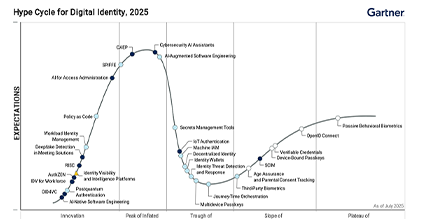Securing identity in the age of agentic commerce

In a world transitioning from storefronts to AI agents, Rolf Lindemann from OneSpan shares how scale and network effects are rewriting trust, payments, and customer experience.
Plus, Rolf adds why digital identity is the control plane for the next wave of commerce.
Commerce keeps reinventing itself. Brick‑and‑mortar relied on human rapport and immediate handover, while ecommerce scaled discovery and delivery (and with it, global fraud).
A third wave is now beginning: agentic commerce, where AI agents shop, negotiate, and transact on our behalf. The prize is speed and personalisation at machine scale. The prerequisite is a verifiable, privacy‑preserving, and interoperable identity that travels with humans, businesses, and agents alike.
From storefronts to screens: how scale rewired trust
In physical retail, trust was local and embodied. You saw the product, paid with cash or EMV-protected cards, and walked out with the goods. This model didn’t compound via strong network effects — reach was limited by geography and footfall.
Ecommerce changed that. Platforms created two-sided networks — more buyers attract more sellers, and vice versa — reinforced by data flywheels that sharpen search, relevance, and conversion.
But scale cut both ways. Online attackers gained leverage with card-not-present fraud, account takeover (ATO), and refund abuse. Estimates put global ecommerce fraud losses at approximately USD 44 bln in 2024, with forecasts exceeding USD 100 bln by 2029.
Industry surveys show similar pressure across merchants globally, with TransUnion finding that companies lost nearly 8% of their revenues to fraud in the past year. That’s why identity moved from a back-office control to a growth lever: every password reset or 2-step login risks cart abandonment.
Passwordless options provide an inviting front door
Consequently, ecommerce leaders are looking for ways to reduce friction in their apps without compromising security. The sign-up and/or sign-in processes were the most significant points of friction for customers, as passwords or magic links via email were needed in practice. Many ecommerce vendors are now replacing passwords with phishing‑resistant options such as passkeys — Amazon and Costco are a few notable examples.
Passkeys are FIDO credentials that combine phishing-resistant security with a great user experience. They are well-suited for convenience-centric and high-security use cases, which both apply to ecommerce.
The FIDO authentication core concept involves using a cryptographic challenge response protocol. It can link user gestures (e.g., biometrics) to cryptographic keys through the FIDO Authenticator, allowing relying parties to get an indication of the authenticator model or even a cryptographic attestation. Relying parties may look up authenticator characteristics through a public service, and these characteristics may be included in the risk decisions performed by the relying party.
When done right, passwordless options like passkeys both reduce account takeover and remove friction at sign‑in. That means driving more logged‑in sessions, better personalisation, and higher average order value.
What agentic commerce changes
The success of ecommerce shows that customers are favouring a quick shopping experience over a truly immersive one in a brick-and-mortar shop. Is there a way to make online shopping even quicker? What if most users don’t really enjoy spending hours comparing various products and then find the cheapest online shop they trust and order from there? This is the promise of agentic commerce.
AI agents don’t just recommend, they act. They compare options, negotiate promotions, execute payments, and monitor delivery. They might even delegate tasks to other agents. Today, the user is typically ‘in the loop’ before committing a purchase. Tomorrow, the user might just define the guardrails for the agent.
That shifts the point of persuasion from the consumer UI to the ‘advisor stack’: user preferences, plus agent policy, plus verifiable merchant claims. Mastercard’s explainer on agentic commerce and PwC’s outlook outline how discovery and checkout increasingly happen inside assistants, not websites.
For merchants, visibility now depends on machine‑readable catalogues and authenticated claims that agents can parse. As Forbes reports, ecommerce vendors are already optimising product data for AI agents to avoid being left off shortlists.
For ecommerce vendors, it means they don’t only have to differentiate human customers from human fraudsters, but also determine if AI agents are trustworthy, working on behalf of customers within the defined guardrails. That will further increase the complexity of digital identity.
AI agents will compete through performance and reach. Performance will ask questions such as, ‘How easy is it for the user to say what is needed? How good are the results?’
Reach will ask questions such as, ‘How many offerings can be included in comparisons? Is the agent able to fully execute the task with the preferred merchant, or is manual interaction needed?’
Sharing usernames and passwords with agents, which then share the passwords with other agents, won’t deliver the security consumers expect and ecommerce vendors need. Requiring CAPTCHAs to tell users and agents apart won’t deliver the user experience that consumers demand.
What is needed instead is the generalisation of the FIDO core concept: digital credentials that include attributes provided by an issuer that can be presented by the user or an agent to the relying party. All backed by cryptographic security but implemented under the hood and interoperable, so it scales to the internet.
What good looks like — actions to take now
Those who play a role in commerce can take actions now to prepare for the digital identity wave of commerce trust.
- Merchants: Publish agent-readable catalogues and policy terms to prepare for agentic commerce. Make the front door more inviting using passkeys to lift human log-ins that still remain, cut ATO, and prevent BOT attacks.
- AI agent vendors: Winning and retaining consumer trust is key to success. This is only possible by adding transparency. Prioritise the use of modern digital credentials for agents with support for consumers to define guardrails and merchants to verify those as opposed to leveraging shortcuts by having agents use user credentials.
- Identity & payments providers: Start supporting digital credentials with personhood attributes and implement agent delegation APIs.
- Authentication Platforms: Make it easy for merchants to distinguish humans from trusted agents from bots.
- Policymakers: Back interoperable identity standards and privacy-preserving Sybil resistance to protect humans while enabling safe automation.
Outlook
Brick-and-mortar proved trust wins. Ecommerce proved identity-driven scale wins. Agentic commerce will prove that agent identities and verifiable consent — anchored by personhood for humans — let us scale trust faster than fraud.
The players who align on open identity standards, agent attestation, and privacy-preserving personhood will own the next network effects; the rest will be negotiating with someone else’s agent.
This article was originally published by Paula Albu on The Paypers on November 11, 2025. Reprinted with permission.
About author
 Dr. Rolf Lindemann works for OneSpan as VP Products and brings more than 20 years of experience in product management, R&D, and operations from the IT security industry. He joined OneSpan through the Nok Nok acquisition, and he is one of the authors of the original passwordless FIDO specification and served as a contributing editor to W3C WebAuthentication and FIDO. Rolf is considered one of the leading experts on identity and authentication and has been a frequent speaker at industry events on topics like FIDO, passkeys, digital credentials, IT Security, and IoT. He has also advised regulatory and Government bodies on the benefits and impact of modern authentication.
Dr. Rolf Lindemann works for OneSpan as VP Products and brings more than 20 years of experience in product management, R&D, and operations from the IT security industry. He joined OneSpan through the Nok Nok acquisition, and he is one of the authors of the original passwordless FIDO specification and served as a contributing editor to W3C WebAuthentication and FIDO. Rolf is considered one of the leading experts on identity and authentication and has been a frequent speaker at industry events on topics like FIDO, passkeys, digital credentials, IT Security, and IoT. He has also advised regulatory and Government bodies on the benefits and impact of modern authentication.







